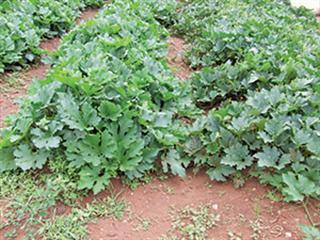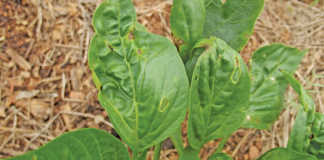
I once chose two varieties of the exact same growth type, which looked identical in all respects and which had been planted at the same spacing, and measured the amount of fruit each produced at maturity. One variety produced 28% more fruit of the same size than the other. I confirmed this result with another trial and made the information available to farmers.
Then one farmer phoned me to say he’d planted both varieties alongside one another and the yields were identical. Amazed, I questioned him further and learnt that his way of determining ‘yield’ was to count the number of female flowers on each runner from both varieties. He didn’t understand that the plant decides how many fruit it deems safe to take to maturity, and each variety starts ‘aborting’ fruit at different times. It’s a process that needs to be monitored – especially when planting a different variety or planting at a different time.
Surprises
Gem squash comes in runner and semi-bush types. The latter sets fruit a lot closer to the crown and then makes runners which are more compact than the other type. Yield potential is also much higher. Given the more compact growth, farmers aiming to maximise the yield per unit area are often inclined to plant the rows too close together. For example, a client of mine once planted a compact type in single rows 1,8m apart – and achieved a yield of 80t/ha.
The farmer then planted another block of the same variety 0,9m apart, doubling the plant population. To his surprise, he only got half the yield. Butternuts can also produce surprises. Here again, you get compact growers and runners, with the latter having different bearing patterns which will influence the optimum spacing for the variety. Some years ago, I decided to use a section of my property for a variety trial for different butternut open pollinated and hybrid varieties. All were spaced wide enough for the potential of each variety to be achieved.
Later, when the leaves died off, I was amazed at the different bearing patterns of each variety. These were all conventional runner types and, seen from a distance, all looked similar while still green and growing. When the fruit was exposed, however, I saw some varieties had set virtually all their fruit fairly close to the crown and then carried on with the runners, producing no more fruit. Others set a lower concentration at a given point and had continued to set fruit along the full length of the runners, providing a more even spread.
Experiment
In this particular trial, with enough room for each variety to perform at its maximum, there were no startling yield differences.
The different bearing patterns did, however, suggest that yield per hectare could have been higher by spacing the rows of those varieties which set nearer to the crown closer together. And I’d advise farmers to look more closely at this aspect. It’s so easy to do a little trial work in the land to ascertain the optimum spacing for each variety and so increase yield per hectare or save on seed, or both.
With baby marrows, which are true bush types, row spacing isn’t so important, as you need to be able to move between the rows easily for the daily harvesting. Spacing in the row can be adjusted to suit the variety to some extent. As sunlight limits the yield when planting too close together, you’ll find the fruit will develop faster if you place the plants a little further apart in the row.
Again, it’s easy to experiment with spacing to find the optimum to suit your purposes.
Contact Bill Kerr at [email protected]. Please state ‘Vegetable production’ in the subject line of your email.












